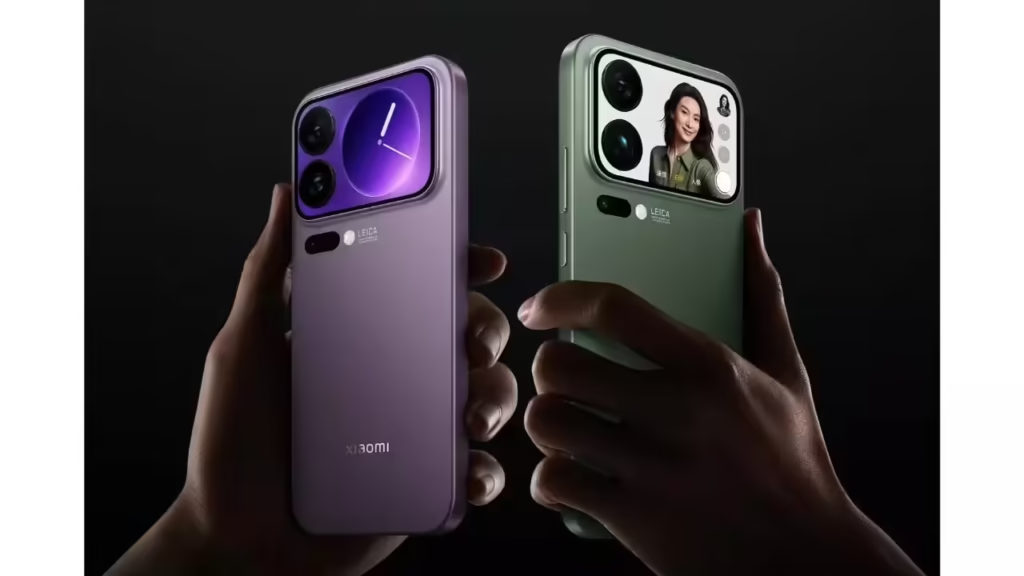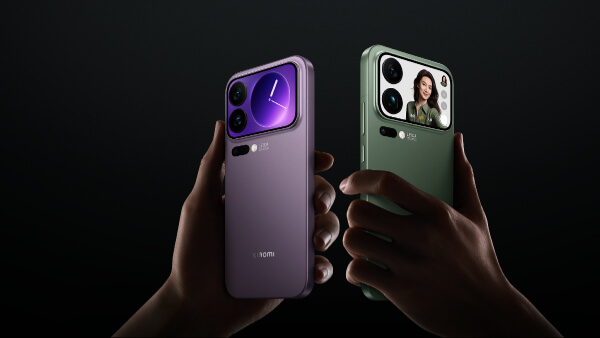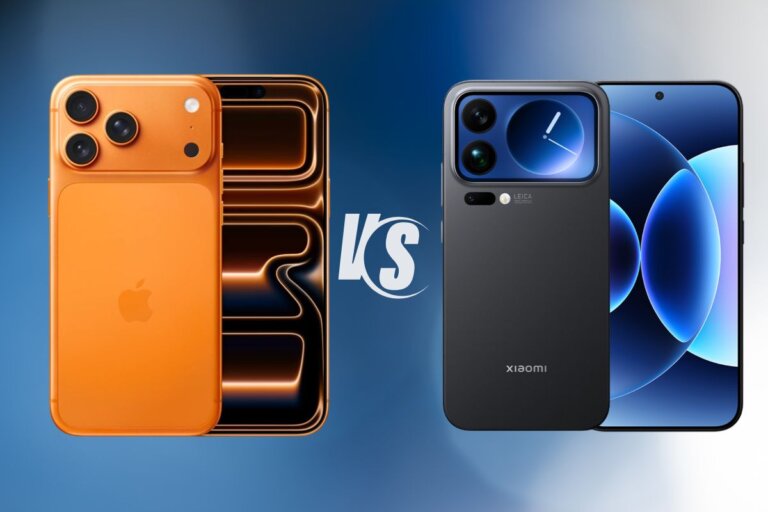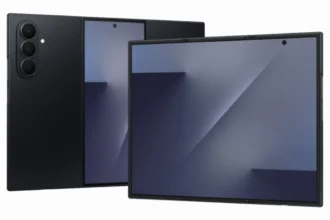In addition to ultimate performance, excluding both devices Xiaomi 17 Pro Max and iPhone 17 Pro Max, they seem to be comparison objects for unique audiences and market strategies. If you find it hard to choose between Android’s masterpiece and iOS protection, you should follow through with this Android vs. iOS in-depth comparison to be certain you have selected the right one for you.
Display Specifications Comparison
The Xiaomi 17 Pro Max sports a larger 6.8 inch display and is slightly bigger overall size wise but it has a noticeable advantage in being considerably thinner and lighter. Moreover, the back of the device is also equipped with a secondary display measuring 2.9 inches by utilising the LTPO AMOLED technology, which will provide for notifications and selfies, using the latest Dragon Crystal Glass 3 as the glass material. The back display is neither a gimmick nor a useless technology, it shapes out as a full-featured and practical component, offering portrait mode view-finding, widget support, and even serving as a gameplay controller.
The iPhone 17 Pro Max is the same traditional attitude, with the use of aluminium and the ceramic shield substrate. Further, it features the slate interface, which we are quite familiar with. The phone boasts a 6.9-inch Super Retina XDR display with Hook display technology, giving it the screen resolution of 2K promotion.

The special feature of Xiaomi is its extreme screen brightness of 3500 nits. This pales iPhone’s 3000 nits for outdoor use. This results in Xiaomi having better outdoor visibility under extreme bright sunlight. They carry an IP68 rating, which means both have been tested for being dust- and water-resistant.
Raw Power vs Optimized Efficiency
The race for the title of the user experience winner turns out to be a competition between the two different approaches to mobile computing. Xiaomi 17 Pro Max contains a Qualcomm Snapdragon 8 Elite Gen 5, while iPhone 17 Pro Max finds its processor node at 3nm in the Elite Gen 5 with a battery capacity of up to 16GB of flash memory and UFS 4.1.
That gives the phones an unparalleled edge in multitasking or in gaming. Apple does not make the RAM volumes available, and the supply chain between hardware and software is their secret for their efficient gaming speeds. On the other hand, the storage options include 256GB and will reach the new benchmark level of 2TB for the large data storage needs of those users who require maximum local storage.

Photography Remains a Crucial Battleground Between These Flagships
Capability or Uniqueness, the space for best snaps now belongs to photography in the never-ending competition among the titans. The Xiaomi 17 Pro Max comes with a combination of 50MP Leica camera module, with a 50MP wide, 50MP periscope telephoto (5x optical zoom), and 50MP ultrawide camera sensor each. The 8K video recording at 30fps and 10-bit Dolby Vision HDR gives the phone an unparalleled video experience. The front camera features the same highly admired 50MP sensor that aspiring social media personas/SNFs will be attracted to.
With the iPhone 17 Pro Max, Apple indeed improved the current era camera innovations with the camera system named Pro Fusion that consists of three 48MP sensors. This smartphone uses a set of cameras with 48MP Main, 48MP Ultra Wide, and 48MP Telephoto lenses, having the tetra-prism design implying an 8x optical zoom (200mm normal range).
Back to the topic of hardware versatility, the Xiaomi brand is behind the 5x optical zoom periscope lens and the front camera that has higher resolution. But this purpose does not cover the main thing, which is computational photography, ensuring uniformity of colour on all the lenses, and based on video processing.

Battery Life and Charging: A Clear Winner Emerges
This category is the one with the greatest delineation between items of different design. Since having a 7500mAh cell in the Xiaomi phone, customers can now use all three ways of charging. One of the most outstanding features of this 100W wired charger is its capability to charge the phone in less than 30 minutes consumers on the go will find that very useful, as never before.
The iPhone 17 Pro Max brings the smaller 5,088mAh battery, which includes a 40W fast charger and 15W Mag-Safe wireless charging. Though Apple has powerfully increased battery life in their latest generation devices, its charging speeds are way slower than those of Xiaomi’s. The lack of a power brick in the package further exacerbates the cost.
Software and Ecosystem: Two Different Worlds
At the core of the iPhone 17 Pro Max, there will be iOS 26, which will put a “Liquid Glass” design aesthetic into place as well. Apple Intelligence has become a crown jewel of its software as it is deeply integrated into the OS and brings AI to end users on a massive scale. It keeps all the iconic features intact, for example, Face ID, Mag-Safe, as well as expands to integrate full-line Apple products.
The Xiaomi 17 Pro Max was released with a strong screw in OS (Hyper-OS 3) based on Android 16, the same having full, extensive customization options and freedom for users. A 6-year software updating period will also be in place to make sure that owners of the Xiaomi smartphones get the supreme benefit.

As for users with a large part of their tech life in the Apple walled garden (MacBooks, iPads, AirPods, and Apple Watch), the greatest continuity features of the iPhone 17 Pro Max are available there. Xiaomi will be a preferable choice for Android users who are into customizability and modularity of software over Apple’s constrained and predictable ecosystem.
Pricing: Value vs Premium Positioning
The price difference is huge, especially when comparing the two product lines, and it could for sure make a difference among buyers. The Xiaomi 17 Pro Max was released on September 25, 2025. The Chinese version of the device was available at these prices: the 12GB RAM with 512GB UFS 3.1 model is 5999 CNY, the 16GB with 512GB, marking a mere incremental cost of 300 CNY at 6299 CNY, and the 1TB model can be gotten for 6999 CNY.
As a global introduction, the base price of 5999 CNY is equal to about 825 USD. The iPhone 17 Pro Max finally saw the daylight, as it was officially unveiled in line with the tradition of Apple’s autumn product line-up.
Meanwhile, in the U.S.A., this basic starting point for at 256GB iPhone 12 Mini is targeted at $699; additional models often command increased prices, and the high-end models might even reach the four-digit range. Through quoting the base models’ pricing, which shows Xiaomi costs $365 less than Apple, Xiaomi is significantly less expensive to purchase on the open market, specifically in emerging markets.
Xiaomi 17 PRO Max is best for powers users, gamers and android enthusiasts seeking maximum performance, fast charging and value for money.On the other hand, iPhone 17 Pro Max is Great for those already committed to the Apple ecosystem, and appreciate polish, reliability, and integration over raw specifications. Both are the best of the best in the smartphone world in 2025 and the best one for you will depend on your priorities (i.e., customization and value, or ecosystem and finish).
Also Explore: Test Twenty Cricket Format Set to Redefine Global Game Rules















